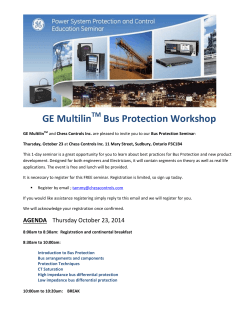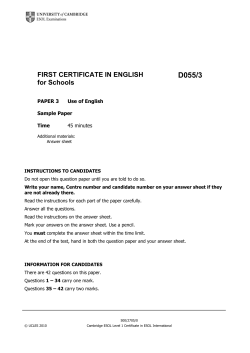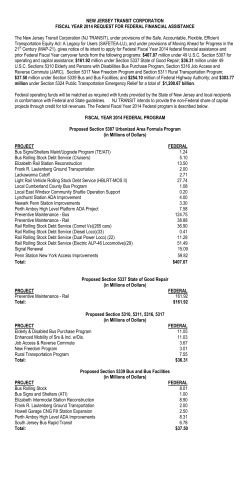
Report sheds light on possible bus system improvements
For more information: For immediate release March 3, 2015 Rob Henken President, Public Policy Forum 414-276-8240 or 414-708-4392 (c) rhenken@publicpolicyforum.org Report sheds light on possible bus system improvements A report released today by the Milwaukee-based Public Policy Forum explores common strategies used by transit systems around the country to enhance the speed and efficiency of their bus services, and finds that several may hold promise to improve transit in Milwaukee and enhance its appeal to the general population. "Our report cites several examples of metro areas that have used creative strategies – often with the help of federal grants – to improve their bus service and make transit a viable option for all commuters," says Forum Senior Researcher Joe Peterangelo, the report's lead author. "When considering their potential relevance here, we find that many of the strategies would involve relatively small changes to existing MCTS bus service, while others could involve substantial capital investment, but all reflect a recognition that high-quality bus service plays an important role in a balanced and effective transportation system." The report is a follow-up to a December 2013 Forum report – Getting to Work – which described the lack of viable mass transit options available to Milwaukee County residents wishing to access jobs in the suburbs. The findings of that report led Forum researchers to ask how other metro areas had addressed similar bus service challenges, as well as how they had responded to the general challenge of improving bus service effectiveness and attractiveness. Using a recent analysis of transit best practices by the Transportation Research Board of the National Academies for guidance, the report identifies and discusses several strategies for improving bus speeds, including the following: The transit authority in Spokane, Washington implemented a “Stop Consolidation Program” to strategically reduce the number of bus stops throughout its system, many of which were added because of requests, as opposed to need. Transit planners point to increased bus speeds and improved travel times since the program’s inception, and they say ridership was on track to set a record in 2014. King County Transit in Seattle grants transit signal priority to buses on six “RapidRide” express bus routes. Buses are equipped with technology that allows them to trigger green lights at busy intersections under appropriate circumstances. This strategy has reduced travel times by an average of 5.5% on the six routes and improved on-time performance. Metro Transit in Minneapolis-St. Paul uses a “Bus-Only Shoulders” program as a low-cost way to provide faster transit service in areas where congestion is a consistent problem. The program allows buses to use shoulder lanes under certain conditions to ensure faster speeds and on-time performance. The program started as an experiment in 1991 and has grown to comprise a network of more than 300 miles along arterial roads and highways. "Each of these strategies has the potential to improve bus speeds and reduce travel times to some extent," says Peterangelo. "But to truly address the prohibitive travel times faced by many reverse commuters, more advanced and expensive strategies may be required, such as bus rapid transit.” The report describes and analyzes the characteristics of bus rapid transit (BRT), which combines a variety of bus system improvements to produce an enhanced level of service. Those may include exclusive bus lanes; stops and stations that allow for level boarding and include real-time vehicle arrival displays and ticket vending machines; articulated vehicles with three sets of doors, thus offering increased capacity and faster boarding; off-board fare collection; and advanced communications technologies, including transit signal priority. Four distinctive examples from across the country that show the spectrum of BRT options are examined. Those range from “BRT lite” (i.e. modest upgrades to express bus routes) to options entailing major capital investments that allow BRT buses to operate similarly to light rail trains. The report concludes by discussing how this range of bus system improvements might be applied in Milwaukee. It suggests that the I-94 east-west corridor may offer the most advantageous setting given that the segment of Wisconsin Avenue extending from Cass Street to 35th Street already is the busiest transit corridor in the region, with 17 different bus routes using all or a portion of that corridor. "The east-west corridor also would be a logical place to introduce a BRT service," says Peterangelo. "Such a route would connect the region's two largest employment centers – downtown and the Regional Medical Center – and would directly serve both UWM and Marquette, while also mitigating the impacts of several years of I-94 reconstruction." The report acknowledges that in light of MCTS’ substantial long-term fiscal challenges, it will be challenging to maintain existing bus services, let alone implement major improvements such as BRT. It notes, however, that "other metro areas facing similar financial challenges have mustered up the resources to implement such improvements, in part because they researched and recognized the benefits that faster and more convenient bus service could bring to their citizens and local economies." The report can be downloaded from the Forum’s website: www.publicpolicyforum.org. It was funded, in part, by a grant from the Helen Bader Foundation. Milwaukee-based Public Policy Forum, established in 1913 as a local government watchdog, is a nonpartisan, nonprofit organization dedicated to enhancing the effectiveness of government and the development of southeastern Wisconsin through objective research of public policy issues.
© Copyright 2025















